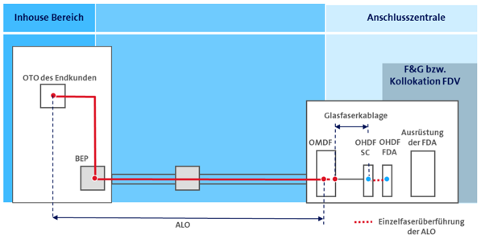by Fredy Künzler
Reading time: 7 minutes
The Internet wholesale market in Switzerland
Most people in Switzerland buy an Internet subscription without thinking about how it is technically structured. All that matters is a fast optical fiber, an average TV cable or – if nothing better is available – a slow copper line. However, as is so often the case in life, this is not an ideal basis for decision-making.
OSI Layer 1
When analyzing the Internet wholesale market, as with many aspects of the Internet industry, an abstraction to the OSI model helps. Let’s start with OSI Layer 1. In most homes in Switzerland, there are two conventional or historical types of cable: the two-wire copper cable for telephony and the television cable. The latter is a coaxial cable and, due to its physical properties, can transmit much higher frequencies than the telephone cable, which consists of a twisted pair of copper wires. A higher frequency means a higher data rate. Therefore, the rule of thumb “TV cable is better than copper cable” is basically correct.
Connected electronics have of course made great strides in the last 25 years. Today, up to 10 Gbit/s are possible on the TV cable (DOCSIS 4.0 standard), while the copper cable only allows a maximum of around 500 Mbit/s. The second-largest Swiss broadband provider now sells its cable connections with a bandwidth of 2.5 Gbit/s, suggesting a clear superiority over copper connections.
However, what no provider says openly: In the cable network, the 2.5 Gbit/s are available to all customers in the same node. This can be a street cabinet, for example, where the TV and Internet signal is distributed in a neighborhood. Depending on the number of customers in the node and their usage behavior, the actual bandwidth delivered is much lower. This is why all providers always add “up to” in addition to the advertised nominal bandwidth. The TV cable network therefore basically corresponds to a point-to-multipoint (P2MP) network topology; this is due to historical reasons, as the coaxial cable was originally built to distribute the one-way TV signal.

In contrast, DSL (Digital Subscriber Line) on copper cable uses a point-to-point (P2P) topology. The nominal maximum of 500 Mbit/s is available exclusively for the respective customer up to the central office. Depending on the overbooking factor, a nominal 500 Mbit/s can therefore be “more” than 2.5 Gbit/s in the cable network in practice. If a TV cable network is overloaded, the provider would have to split the node and redistribute the customers. However, this is cost-intensive and some providers have hesitated (too) long in the past to make the necessary investments, which has led to quality problems. Operating a TV network is also demanding and therefore comparatively expensive.
This is why fiber optics are being used in many places in Switzerland, and not just for marketing reasons, of course. Optical fiber is not only much faster, but also more energy-efficient, low-maintenance and durable. The investment therefore pays off in the long term. There was also a debate about the correct network topology in the fiber optic network – i.e. P2MP versus P2P. In Switzerland, this debate culminated in the so-called “fiber optic dispute”, a sensational antitrust case that resulted in P2MP being banned for the ex-monopolist.
OSI Layer 2
If we look at OSI Layer 2, the situation is different. For copper cable, so-called DSLAMs (Digital Subscriber Line Access Multiplexers) are used on the provider side. For TV cable, it is a CMTS (Cable Modem Termination System) that aggregates the customer connections. With fiber optics, most providers use an OLT (Optical Line Terminal), the technology used is called XGS-PON (X = 10, G = Gigabit, S = symmetrical, PON = Passive Optical Network). XGS-PON? Surely the P2MP network topology is used here and this was banned by the Competition Commission in the fiber optic dispute?
In fact, the legal P2P network topology also enables P2MP by installing the necessary splitters in the central office. Because XGS-PON is cheaper per customer connection, many providers rely on this technology. Init7 and a few other providers, however, use Ethernet – read more about this in our blog article on overbooking.
Pre-service products for providers
Depending on the technology, i.e. DSL, cable or fiber optics, the available pre-service products available, if any, will vary. In Switzerland, coaxial cable services can only be obtained from one provider at a time. Sunrise has been the top dog since the former UPC was merged. Depending on the region, Quickline is available with its partners, while Netplus operates many cable networks in French-speaking Switzerland. What all these networks have in common is that they do not provide wholesale offers. It is therefore not possible for alternative providers to use cable network infrastructures.
Layer 2 advance service: BBCS
Layer 2 advance service: BBCS
DSL, on the other hand, i.e. connections on the telephone network, can be obtained relatively easily everywhere as a resale product. The incumbent’s offer is called BBCS (Broadband Connectivity Service) and can also be used for fiber optic connections (BBCS-F). From the provider’s point of view, it is a layer 2 wholesale product, although strictly speaking it is actually based on layer 3. BBCS provides the provider (TSP, telecommunications service provider) with a connection between the end customer connection and one or two redundant transfer points that aggregate all end customer connections.

Source: Swisscom
The advantage for the provider is that it can connect end customers throughout Switzerland with relatively little investment. The disadvantage: The entire technology is predetermined. The provider is only a reseller of prefabricated broadband profiles and can do little itself. Innovation is impossible.
Providers that use BBCS include green.ch and iWay, as well as the end customer connections of the former monopolist and its secondary brands Wingo and M-Budget. Init7 also uses BBCS for connections on copper lines (Copper7) and fiber optics that are not yet covered by Fiber7 pops (Hybrid7).
Another pre-service product on layer 2 is called “LiteXchange” from Litecom, but it has comparatively low coverage and is only available regionally. Init7’s product on this platform is called Crossover7.
In addition, some municipal utilities offer their own layer 2 wholesale product. In Zurich, for example, it is sold as “Zürinet”; this pre-service product, also known as FCS (Fiber Connectivity Service), is used by GGA Maur, among others. Here too: Prefabricated connections with different labels. However, ewz – Elektrizitätswerk der Stadt Zürich is not transparent towards end customers and does not declare which providers use layer 2 and which layer 1.
Layer 1 wholesale: ALO and FLL
Layer 1 wholesale: ALO and FLL
If a provider wants to be more independent of the available wholesale services and make its own decisions regarding technology and offers, it needs much more investment and know-how than with pure BBCS reselling. The layer 1 wholesale services of the ex-monopolist are called ALO (Access Line Optical), those of the municipal utilities are called FLL (Fiber Local Loop). From a technical point of view, ALO and FLL are absolutely identical; it is a continuous optical fiber from the end customer’s connection (OTO, Optical Termination Outlet) to the respective central office.

The provider (FDA) must install its own equipment at the head office. Although this is time-consuming and costly, it guarantees maximum flexibility in terms of technology and product design for end customers. Init7 already has over 330 PoPs in operation throughout Switzerland (as of January 2025). All fiber optic connections in the respective catchment areas can therefore benefit from Fiber7, Easy7 and Ethernet7 – the former is known to offer a bandwidth of 25 Gbit/s. This would not be possible with conventional layer 2 wholesale offerings, namely BBCS. Other providers such as Salt and Sunrise also rely on ALO and FLL as wholesale services. With large volumes or many customers, profitability is much better in the long term if a provider relies on layer 1. In fact, layer 2 wholesale products are subsidized in many places; providers who do not invest in their own electronics in the central offices do not pay cost-covering prices for layer 2, especially in the case of municipal utilities.
Conclusion:
Choosing the right internet subscription is usually driven by nominal bandwidth and price. But a shiny package or a bargain deal is rarely a sustainable choice, because not only the wholesale product used is crucial for the quality and user experience, but especially the overbooking on layer 2 and the control of data traffic (layer 3).
